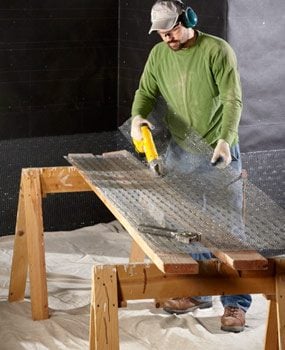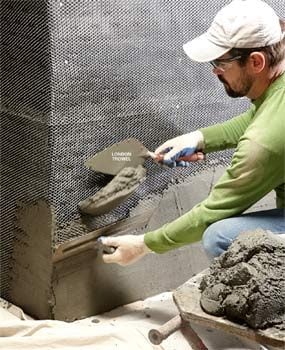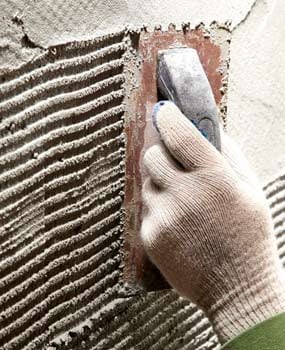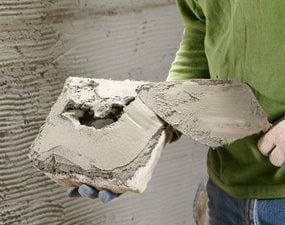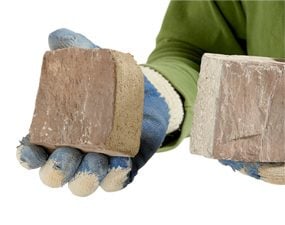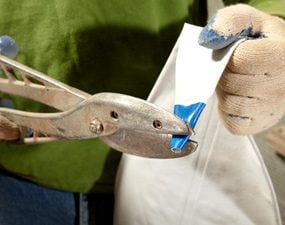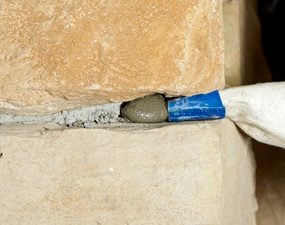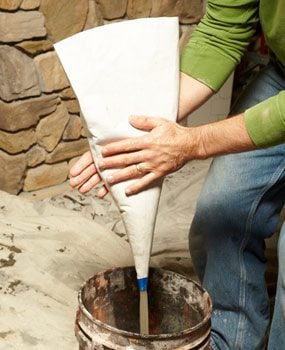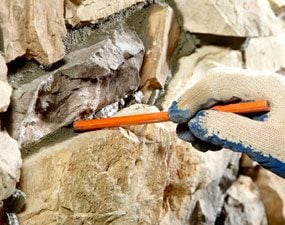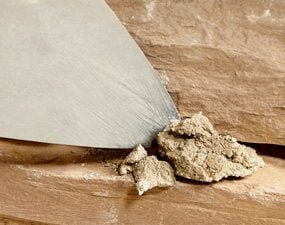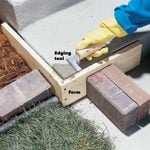Modern Stone Installation Tips
Updated: Feb. 20, 2023Tips for installing veneer stone from a real pro

The benefits of modern stone veneer
If the words “cultured stone” conjure up images of a fake that you can spot a mile away, then you need to take a look at modern manufactured veneer stone. Today’s versions look so good that you’ll be hard-pressed to tell them from actual stone. And since manufactured stone is cheaper and lighter than the real thing, it’s a great DIY choice for any stone veneer project such as a stacked stone veneer fireplace.
There are several national brands of manufactured stone—including Eldorado, Coronado and Cultured Stone—and they all provide detailed installation instructions on their Web sites. But we were sure that a professional would have tons of great tips and advice, so we enlisted Marcus Schilling, a third-generation mason, to show us how he installs it. And sure enough, we were right.
You can use manufactured stone indoors or out, but exterior applications require special attention to details of waterproofing and flashing. Before installing exterior stone veneer, talk to your local building inspector to see what’s required in your area. We’ll show you tips for installing it indoors; however, most of the tips also apply to exterior applications.
Stone Veneer in a Nutshell: Installation Basics
Before we launch into the tips, it’s helpful for you to have a general idea of the installation process. Almost all stone veneer installations start with a layer or two of building paper, covered by properly installed dimpled and galvanized wire lath. The next step is to cover the lath with a 1/2 in. layer of Type S mortar, which is “scratched” while it’s still wet to allow the stone to cling better. After this “scratch coat” dries overnight, the stone is applied with the same type of mortar. If you’re using stone intended to look like it’s dry-stacked—that is, no mortar between the stones—you’re done. Otherwise you’ll finish the job by grouting the joints between the stones with mortar.
Marcus the Mason
Marcus Schilling was introduced to the world of masonry when he was only 7 years old. He helped his dad with all sorts of stonemason tasks, including carrying small stones and cleaning up at the end of the day. And he loved it from the start. His grandpa was a stonemason. His grandpa taught his dad, and his dad taught Marcus and his brothers. And now Marcus is teaching his sons—and us!—the craft of setting stones and laying bricks.
Tip 1: Cut wire lath the easy way
Wire lath can be unruly, and the cut edges are sharp. So anything you can do to keep the stuff under control while you’re cutting it is a big bonus. Here’s a tip from Marcus on how to make long cuts. Lay the wire lath on some long boards. Measure from the edge of the lath to the edge of the board on each end so the desired cutting line is lined up with the edge of the board. Then secure the lath temporarily with a few staples. Now use the edge of the board as a guide to make the cut. Marcus uses cordless metal shears, but tin snips or aviation snips will also work.
More tips for working with lath:
- Wear gloves and safety glasses.
- Cut wire lath with large tin snips, power metal shears or a diamond blade mounted in an angle grinder.
- Prebend lath at inside corners. Bend it over a board before putting it in place.
- Make sure the lath is installed so it feels rough when your hand is going up, and smooth going down. However, it’s important to check with your specific lath manufacturer guidelines, as they may give different instructions.
Tip 2: Speed up troweling for modern stone veneer
Marcus swears this is the fastest way to get the mud on the wall. Prop up your mud board about 16 in. high and within easy reach. Load it with mortar. Then use your London trowel as shown to transfer the mortar from the mud board to your trowel. Pull the trowel up the wall to embed the mortar in the lath.
What kind of mortar should you use?
You’ll find recipes for mixing your own mortar in the stone manufacturer’s instructions, but Marcus uses premixed Type S mortar that’s labeled for use with veneer stone. Special additives are already included—all you add is water. Look for it at masonry suppliers or ask about it when you buy your stone.
Tip: When installing “dry-stack” stones, use a colored mortar or dye the mortar to match the stones.
Tip 3: Use a tile trowel to scratch the mortar
Grooving or scratching the wet mortar provides a better bond for sticking on the stones. You can buy a special rake-like tool for this, but Marcus prefers to use a 3/16 in. square-notched tile mastic trowel. They’re cheap and easy to find at home centers and hardware stores. Simply drag it across the wet mortar to make horizontal stripes.
Tip 4: Stick on the stone like a pro
Marcus makes a swipe across the entire back of the stone with the trowel first to create a good bond for the mortar bed. Then he wipes mortar from the trowel all around the perimeter. This creates a little hollow spot in the middle that will act as a suction cup to hold the stone in place until the mortar hardens. The key is to put on enough mortar to create about a 1/2 in.-thick layer when the stone is pressed against the scratch coat. If any mortar oozes out around the edges, knock it off with the trowel so it doesn’t get in the way of grouting.
Tip 5: Disguise the cut ends of stones
Occasionally you’ll have to cut stones to fit. Marcus uses a 10-in. chop saw equipped with a dry-cut diamond blade. But if you’re doing only one job, you can get by with a diamond blade mounted in an angle grinder. Regardless of the tool you use, you’ll want to disguise or hide the cut ends. After cutting a stone, Marcus cuts angles on the corners to make them look more natural. You can also use a tile nipper or horse-hoof trimmer to chip away at the sharp edge left by cutting. Marcus chooses thin stones to cut if possible. Then he hides the cut edge against a thicker stone. And if he’s using mortar that’s dyed to match the stone, as you would in a dry-stack installation, Marcus butters the end of the stone so it blends in better.
Tip 6: Cut off the tip of the grout bag
Grout bags come with either metal or plastic tips. Marcus prefers the plastic tips for grouting stone. He cuts the tip to create an opening that’s about 5/8 in. in diameter to allow proper mortar flow. Marcus says a common mistake is to mix grouting mortar too stiff. Make sure the mortar is loose enough to ooze from the tip without having to squeeze the bag.
Tip 7: Fill the joints completely
Marcus says he often encounters hollow grout joints on work done by beginners. Be careful to fill the joints full from back to front as you’re grouting. Joints that are hollow underneath will fall out later. Keep the tip pressed deep into the joints so they get filled from the back to the front of the stone.
Tip 8: Rinse the bags to avoid grout build-up
Marcus recommends rinsing out the bag after every third bagful of grout. Otherwise sand builds up along the edge, clogs the tip and makes grouting difficult. Just fill the empty bag with water and rub it back and forth to dislodge the caked-on grout.
Tip 9: You don’t need a special tuckpointing tool!
Marcus finishes the joints using a 3/8 in.-wide tuckpointing trowel that he’s cut off to about 5 in. long. He says most masons prefer the shorter length because it gives them much better control. But he says a carpenter’s pencil is a great alternative. It’s the perfect size and shape for striking your grout joints. Let the grout set up until it’s firm to the touch but not hard. Usually this is about 20 to 30 minutes. Then rake the pencil over the grout to smooth and shape it. Finish up by brushing off any loose mortar with a soft masonry brush.
Tip 10: Wait! Don’t wipe off that wet mortar
When you spill a glob of mortar on the stone, which is almost certain to happen, leave it alone. Let the mortar set up about 30 minutes. Then flick the partially hardened mortar off with the tip of the trowel. Dab the remaining residue with a damp rag to remove it.
Cleaning Manufactured Stone
A lot of people clean their manufactured stone wrong during installation, according to masonry expert Morris Rozema. “People think they’ll do their cleanup at the end of the project. But by then it’s too late to remove hardened mortar or grout without the risk of damaging the stone. You need to clean up at least daily. This is not optional, and I can’t stress this enough.”
When it comes to maintenace cleaning, scrub dirt off manufactured stone with a stiff-bristle brush using a mild detergent and water. For tougher cleaning problems, Rozema suggests using one part white vinegar mixed with eight parts water.
“Premoisten the stone with clean water, dip a plastic or brass brush (never use a steel wire brush on manufactured stone) in the vinegar/water mix and lightly scrub the area. Then rinse the area immediately with clean water to remove all of the vinegar/water mix from the surface.”
Although most synthetic stone manufacturers warn against using harsh cleaning or bleaching products or pressure washers on their stones, Rozema says he’s used them on severely stained and moldy areas of stone at his own home without adverse effects.
“But I always test the cleaner or bleach in an out-of-the-way area to see if the stone or mortar color runs.” Rozema cautions that the use of virtually all cleaners/bleaches/acids or pressure washers can void the manufacturer’s warranty. “If you use these things, proceed with extreme caution and at your own risk.”
Meet the cleaning expert:
Morris Rozema has been involved in the masonry industry for more than 40 years and is the president of Sandy Stone & Brick, a masonry supply business in Sandy, Oregon.
Required Tools for this Project
Have the necessary tools for this DIY project lined up before you start—you’ll save time and frustration.
- Angle grinder
- Hammer
- London trowel
- Notched trowel
- Safety glasses
- Stapler
- Steel trowel
- Tape measure
- Tin snips
Required Materials for this Project
Avoid last-minute shopping trips by having all your materials ready ahead of time. Here’s a list.
- Grout
- Modern veneer stone
- Mortar
- Wire lath
